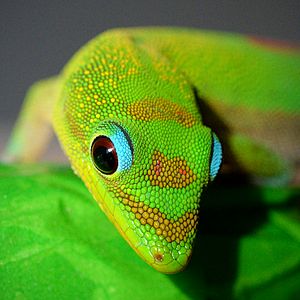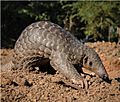Scale (anatomy) facts for kids
A scale is a small, tough plate that grows from an animal's skin. Scales help protect animals. You can find scales on many different animals, like fish, reptiles, birds, and even some mammals. They have developed in different ways over time, but their main job is often protection. For butterflies and moths, scales on their wings give them their beautiful colors!

Scales are part of an animal's outer covering, called the integumentary system. There are many types of scales, depending on their shape and the kind of animal they are on.
Contents
Fish scales
Fish scales grow from the deeper layers of their skin. Interestingly, the same genes that help teeth and hair grow in mammals also help scales grow in fish!
Cosmoid scales
True cosmoid scales are found on a group of fish called lobe-finned fish. These scales have a strong inner layer made of bone. On top of that is a spongy bone layer, then a material called cosmine (which is like dentin, found in teeth). The very top layer is made of keratin, a tough protein. The coelacanth has a changed type of cosmoid scale that is thinner and doesn't have cosmine.
Ganoid scales
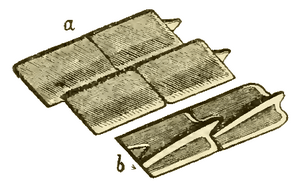
Ganoid scales are found on fish like gars and bichirs. These scales are similar to cosmoid scales, but they have a special shiny layer called ganoin. Ganoin scales are shaped like diamonds, are very shiny, and feel hard. The shine comes from special compounds found in the ganoin, which are related to guanine (a part of DNA).
Placoid scales
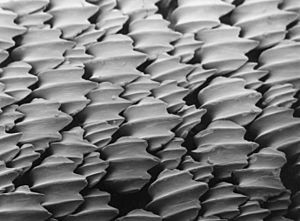
Placoid scales are found on cartilaginous fish, which include sharks and rays. These scales are also called "denticles" because they are very similar in structure to tiny teeth. Each placoid scale usually has one main spine and two smaller spines on the sides.
Leptoid scales
Leptoid scales are found on most modern bony fish. As these fish grow, their scales add new layers in circles, like tree rings. These scales overlap each other, like roof tiles, from the head to the tail. This smooth arrangement helps water flow easily over the fish's body, making it easier for them to swim fast. There are two main types:
- Cycloid scales have a smooth outer edge. You can find them on fish with soft fin rays, like salmon and carp.

- Ctenoid scales have a rough, toothed outer edge. These are usually found on fish with spiny fin rays, like bass.
Reptilian scales
Reptile scales come in different types, such as cycloid (smooth), granular (bumpy), and keeled (with a ridge in the middle). The size of scales often changes across a reptile's body. Larger, tougher scales cover areas that get a lot of wear and tear, like the feet, tail, and head. Scales around joints are smaller to allow for easy movement. Many snakes have extra wide scales on their bellies that stretch from side to side, helping them grip the ground and move.
All reptile scales have an outer part that you can see. Many reptiles, like crocodilians (alligators and crocodiles) and turtles, also have bony plates called osteoderms underneath their outer scales. These are like built-in armor. Snakes and many lizards do not have osteoderms.
Avian scales
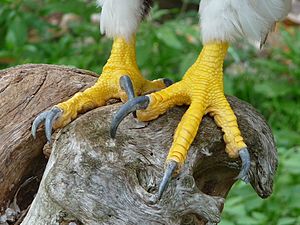
Birds have scales mainly on their toes and lower legs. In some birds, scales might extend higher up the leg. Scientists used to think bird scales were similar to reptile scales. However, it's now believed that bird scales developed separately and are actually like very small, flattened feathers.
Mammalian scales
One well-known example of a scaled mammal is the pangolin. Its scales are made of keratin, the same material found in our fingernails and hair. These scales are used for protection, much like an armadillo's armor. Pangolin scales developed on their own, not from their ancient reptile ancestors, even though they use a similar gene.
Other mammals also have scales. The musky rat-kangaroo has scales on its feet and tail. The Anomalure (a type of rodent) has scales on the underside of its tail. The tough skin on the foot pads of most mammals is also thought to be similar to scales found on other animals.
Arthropod scales

Butterflies and moths, which belong to the group called Lepidoptera (meaning "scale-winged" in Greek), have wings covered in tiny, delicate scales. These scales are actually modified hairs. Each scale is made of many tiny, thin layers of material stacked together. Butterfly scales are usually broad and flat, while moth scales tend to be narrower and more hair-like.
These scales often contain pigments that give them color. But some scales are metallic or iridescent (shimmering with different colors) without any pigments. This happens because the thickness of the scale layers is similar to the wavelength of visible light. This causes light to reflect in special ways, creating amazing structural colors and iridescence. The most common color made this way is blue, seen in Morpho butterflies. Other colors can be seen on the sunset moth.
Images for kids
-
Scale-covered Indian pangolin.
See also
 In Spanish: Escama para niños
In Spanish: Escama para niños


